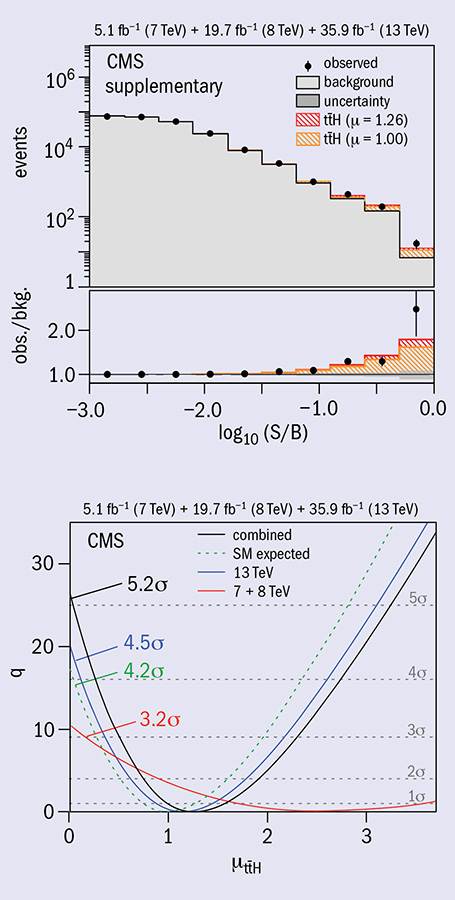The CMS collaboration has published the first direct observation of the coupling between the Higgs boson and the top quark, offering an important probe of the consistency of the Standard Model (SM). In the SM, the Higgs boson interacts with fermions via a Yukawa coupling, the strength of which is proportional to the fermion mass. Since the top quark is the heaviest particle in the SM, its coupling to the Higgs boson is expected to be the largest and thus the dominant contribution to many loop processes, making it a sensitive probe of hypothetical new physics.
The associated production of a Higgs boson with a top quark–antiquark pair (ttH) is the best direct probe of the top-Higgs Yukawa coupling with minimal model dependence, and thus a crucial element to verify the SM nature of the Higgs boson. However, its small production rate – constituting only about 1% of the total Higgs production cross-section – makes the ttH measurement a considerable challenge.
The CMS and ATLAS collaborations reported first evidence for the process last year, based on LHC data collected at a centre-of-mass energy of 13 TeV (CERN Courier May 2017 p49 and December 2017 p12). The first observation, constituting statistical significance above five standard deviations, is based on an analysis of the full 2016 CMS dataset recorded at an energy of 13 TeV and by combining these results with those collected at lower energies.

The ttH process gives rise to a wide variety of final states, and the new CMS analysis combines results from a number of them. Top quarks decay almost exclusively to a bottom quark (b) and a W boson, the latter subsequently decaying either to a quark and an antiquark or to a charged lepton and its associated neutrino. The Higgs-boson decay channels include the decay to a bb quark pair, a τ+τ– lepton pair, a photon pair, and combinations of quarks and leptons from the decay of intermediate on- or off-shell W and Z bosons. These five Higgs-boson decay channels were analysed by CMS using sophisticated methods, such as multivariate techniques, to separate signal from background events. Each channel poses different experimental challenges: the bb channel has the largest rate but suffers from a large background of events containing a top-quark pair and jets, while the photon and Z-boson pair channels offer the highest signal-to-background ratio at a very small rate.
CMS observed an excess of events with respect to the background-only hypothesis at a significance of 5.2 standard deviations. The measured values of the signal strength in the considered channels are consistent with each other, and a combined value of 1.26 +0.31/–0.26 times the SM expectation is obtained (see figure). The measured production rate is thus consistent with the SM prediction within one standard deviation. The result establishes the direct Yukawa coupling of the Higgs boson to the top quark, marking an important milestone in our understanding of the properties of the Higgs boson.
Further reading
CMS Collaboration 2018 arXiv:1804.02610 (accepted by Phys. Rev. Lett.).
CMS Collaboration 2018 arXiv:1803.05485 (submitted to J. High Energy Phys).
ATLAS Collaboration 2018 Phys. Rev. D 97 072003.








